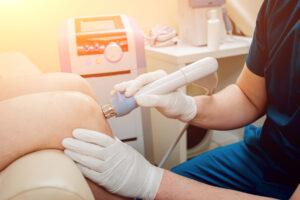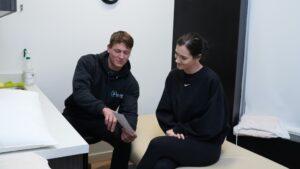What is Cold Laser Therapy?
Cold laser therapy treatment makes use of intense beams of pure light from specific wavelengths. These wavelengths activate localized energy cells to promote healing and decrease inflammation as well as provide relief from acute and chronic pain. This therapy treatment is non-heating and pain-free.
CLT has a bio-stimulating effect to enhance the natural cell activity in the body, speeding up the healing process. Ultimately, this helps repair muscle tissue. The treatment is versatile and can be used on many different chronic and acute conditions for pain relief while serving as an additive in conjunction with other modalities or manual therapies.
There is no radiation associated with the treatment itself.
Benefits of CLT include:
- Non-invasive: The laser doesn’t break the skin and requires no prolonged recovery time.
- Non-thermal: No heat is emitted to the body tissues.
- Pain-free: No pain or feeling associated at all during treatment.
- Able to treat a variety of chronic + acute conditions: A variety of conditions such as muscle strains, tendonitis, arthritis, neck/lower back pain, tennis elbow, and more can be treated.
- Decreases inflammation: Reduces swelling and redness.
Why is it called “Cold” Laser Therapy?
The term “cold” laser comes from the fact that the machine uses low-level light energy, which stays cold and does not emit heat to any body tissues.
Other lasers considered “hot” lasers, such as Intense Pulsed Light Therapy (IPL) use a thermal change in the skin to produce new growth. Cold lasers help to repair the cells and are non-thermal, meaning they do not need heat to do this.
It’s of note to that there are different classes of lasers.
“Cold” falls under class 3. Class 3 lasers are used in many physiotherapy clinics, specifically to help repair muscle tissues.
“Hot” falls under class 4. Class 4 lasers, when used in medical treatments, will cut, burn, or vaporize, and are also used in the military or industrial fields.
Laser therapy can be used to treat:
CLT can be used on a multitude of different acute and chronic conditions such as:

- Tennis and golfer’s elbow
- Ligament and tendon strains/sprains/tears
- Fibromyalgia
- Carpal Tunnel Syndrome
- Tendonitis, tendinopathy, or bursitis
- Osteoarthritis
- Plantar Fasciitis
- Neuropathic pain
What to Expect During Your CLT
As there is no heat or pain associated with this laser, you won’t feel anything during your treatment. Your physiotherapist will place a handheld laser head directly on the affected area. Depending on the injury, they’ll select the wavelength suitable for you and adjust the intensity level. Infrared clusters of blue and red light will penetrate the tissues for a few minutes, beeping to notify once the laser is done.
Before starting the machine, you’ll be given laser safety glasses that need to be worn during the duration of treatment. Multiple areas can be lasered during one session!
Contraindications
Pregnancy – It is recommended that pregnant women not undergo laser therapy since the effects on unborn children are unknown.
Cancer – CLT shouldn’t be used over any suspicious cancerous lesions or carcinoma.
Epileptics – Low-frequency visible light may trigger a seizure in photosensitive, epileptic patients.
Eyes – There shouldn’t be any direct lasering of the eyes. The laser can cause permanent eye damage (which is why we always use protection at Synergy Rehab).
There are no side effects from receiving laser therapy!
The only disadvantage to laser therapy is the number of treatments you may need, as most patients don’t receive full relief after the initial treatment session. At Synergy Rehab, we utilize cold laser therapy as an additive to other treatment modalities, such as massage therapy, for optimal recovery results.
Cold Laser FAQ
What is the difference between cold laser therapy and red light therapy?
Cold laser therapy and red-light therapy are both considered low level light therapies (LLLT) and both utilize a red light. The long wavelengths stimulate pigment molecules in the mitochondria of skin cells to produce chemicals the body needs for healing and repair, which is why you may see red light therapy being used by medical aestheticians to treat skin appearance such as acne, wrinkles, and scarring.
Is low level laser therapy (LLLT) the same as cold laser?
LLLT is a broad term used to categorize lasers that have a low level of light waves emitting from them (ex: cold laser therapy, red light therapy).
How often can you do cold laser?
Cold laser therapy has a cumulative effect. It’s best to receive cold laser treatment twice a week for the duration of your recovery process.
Does cold laser penetrate bone?
Bones, along with muscle and other soft tissues, are transparent to certain laser lights which means the laser light can safely penetrate. Depending on the dosage and output power of the laser machine, low level light therapy can stimulate cellular metabolism, as well as increase the synthesis of proteins. All these changes contribute to bone regeneration.









